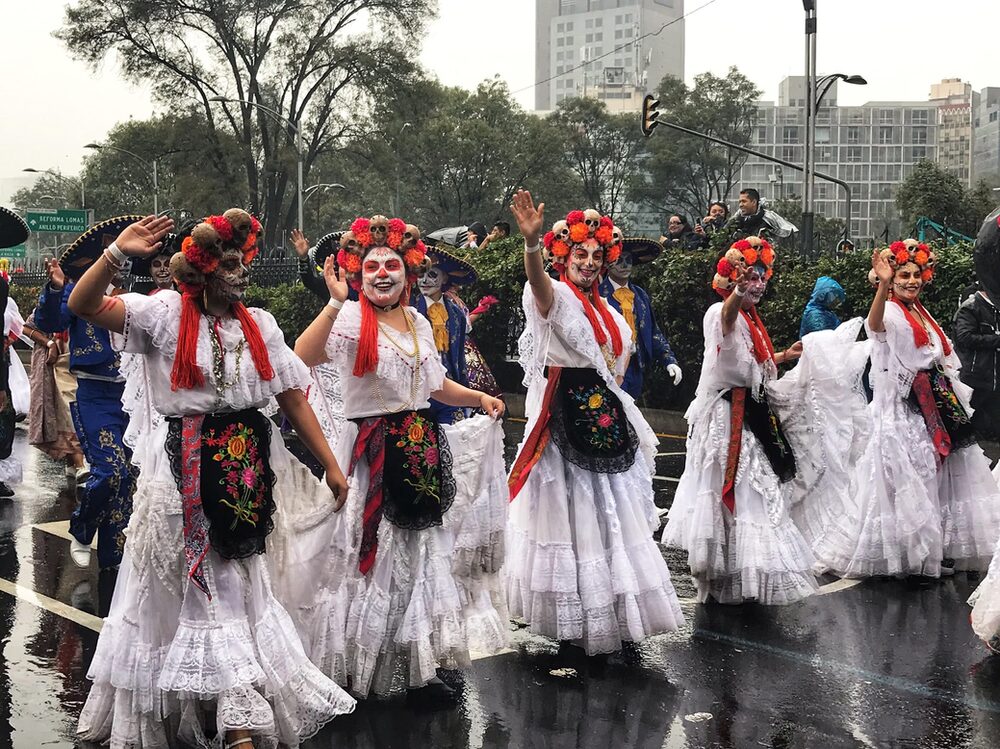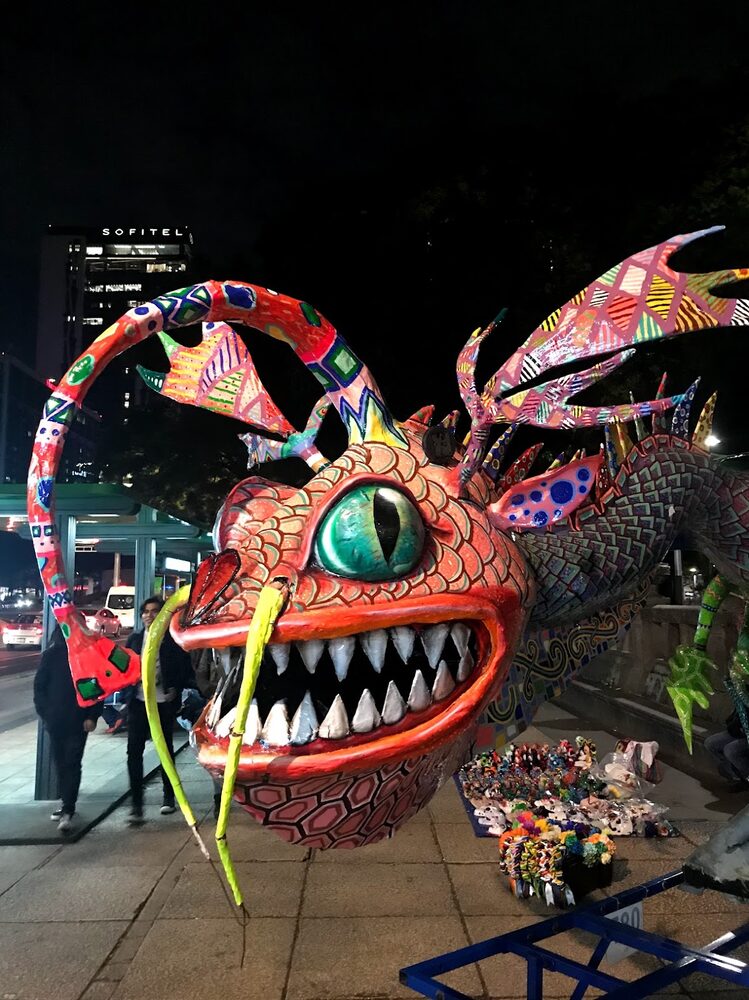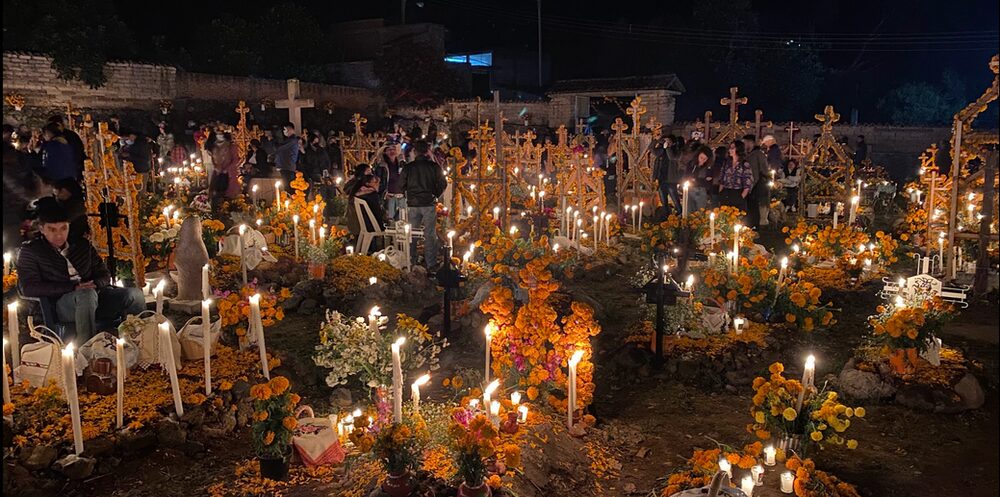It may seem early to start thinking about November, but if you are interested in experiencing this beautiful celebration in one of the most popular spots, then the time is now! This lively festival, celebrated on November 1st and 2nd, is a colorful and joyful way to honor loved ones who have passed on. The festivities include stunning parades, delicious food offerings, and elaborate altar displays. But don’t just take my word for it, read on to discover the best places to experience this celebration in Mexico and start planning your 2023 trip!
Important Dates
-
- October 31: eve of Dia de Muertos aka noche de brujas (night of the witches).
- November 1: Day of the Innocents, commemorates deceased children.
- November 2: the actual Day of the Dead.
Mexico City
-
- El Gran Desfile de Día de Muertos parade travels up Av. Paseo de la Reforma, and ends at the Zocalo. Saturday Oct 28th (to be confirmed)
- Ofrendas in the Zocalo October 28 to November 2
- Be sure to visit Xochimilco for daytime celebrations and the night of La Llorona
- Also check out the festivities and decorations in Coyoacán
Oaxaca
-
- October 31, visit cemeteries in Xoxo, can arrive at 10-11pm and stay until very late
- November 1, Comparsas in San Augustín Etla
- Explore the colorful Jalatlaco neighborhood and eating some delicious Oaxacan food
- November 2, stay in town, as there are typically parades and festivities in Oaxaca city
Patzcuaro
-
- October 21-November 2: Festivities throughout town, including live music and stands to buy ofrenda supplies and get your face painted
- November 1- Wait until nightfall, then visit graves in Arocutín, Lázaro Cárdenas, and Erongarícuaro
- Take a candle-lit traditional boat out to the island of Janitzio
- November 2– visit Tzintzuntzan in the afternoon and early evening
San Miguel de Allende
-
- October 28 and 29, in the Main Garden, a visual show will be accompanied by a DJ and lighting, from 7:00 p.m. to 10:30 p.m.
- November 1– La Catrina Parade, 5pm (to be confirmed)
- November 1, in the Plaza de San Juan de Dios, public ofrendas, music, and related activities (to be confirmed)
Is Dia de los Muertos Mexican Halloween?
Dia de los Muertos is often compared to Halloween due to its timing, but it is a vastly different celebration. While Halloween is often associated with spooky costumes and trick-or-treating for candy, Dia de los Muertos is a time to honor and remember loved ones who have passed away. It is a colorful and lively celebration that embraces death as a natural part of life, rather than fearing it. The holiday has ancient roots in indigenous Mexican cultures, and has evolved over time to include elements of Catholicism. Despite the commercialization of the holiday in some areas, it remains an important cultural tradition in Mexico and beyond.
Some Traditions you might See

Ofrendas
A Dia de los Muertos ofrenda, or altar, is an integral part of the celebration. The ofrenda is typically adorned with vibrant marigold flowers, candles, and photographs of deceased loved ones. It is believed that the ofrenda helps guide the spirits of the departed back to the world of the living for one night. Offerings such as their favorite foods, drinks, and possessions are also placed on the altar. Each element of the ofrenda holds special significance, such as the candles representing the four elements and the papel picado, or cut paper, symbolizing the fragility of life. The ofrenda is a beautiful and deeply meaningful way to honor and remember those who have passed on.
Sugar Skulls and Pan de Muertos
Pan de Muertos and Sugar Skulls are two iconic foods associated with Dia de los Muertos. Pan de Muertos is a sweet bread that is often placed on the ofrenda or altar as an offering to the deceased loved ones. The bread is decorated with small pieces of dough that resemble bones, which represent the idea of life and death being intertwined. Sugar Skulls, on the other hand, are colorful candies made of sugar and decorated with icing. They are often used as decorations on the ofrenda or worn as face paint during the festivities. The sugar skulls are meant to represent a departed soul and the celebration of their life. These two traditional foods are not only delicious but also hold significant cultural and spiritual meaning during Dia de los Muertos.

Marigolds
Marigolds, or cempasúchil in Spanish, hold significant symbolism in Dia de los Muertos celebrations. These vibrant orange flowers are believed to help guide the spirits of the deceased back to the living world. It is said that the bright color and scent of the marigolds help to awaken the spirits and guide them towards the ofrenda, where they will be welcomed by their loved ones. Marigold petals are often used to create intricate designs on the ground leading to the ofrenda, or they may be strewn around the altar to create a path for the spirits. The use of marigolds in Dia de los Muertos is a beautiful representation of the connection between life and death, and the importance of honoring and remembering our ancestors.

Parades
A Dia de los Muertos parade is a lively and colorful celebration of life and death. You’ll see people dressed in colorful costumes, dancing and singing to traditional music. Elaborately decorated floats carrying larger-than-life skeleton figures wind their way through the streets, accompanied by fireworks and cheering crowds. The parade often ends at a cemetery, where families gather to remember and honor their loved ones who have passed away. It’s a truly unique and unforgettable experience that showcases the rich culture and traditions of Mexico.

La Catrina
La Catrina is one of the most recognizable symbols of Dia de los Muertos. The iconic figure is a skeleton woman dressed in elegant clothing, often wearing a wide-brimmed hat decorated with flowers. The character was created by Mexican artist Jose Guadalupe Posada in the early 1900s as a social commentary on the class divide in Mexico at the time. Today, La Catrina has become a beloved symbol of the holiday and is often depicted in art and decorations. Some people even dress up as La Catrina during Dia de los Muertos celebrations, embracing the idea that death is a natural part of life and can be celebrated with joy and humor.

Music and Dance
Music is an essential part of the Dia de los Muertos celebration, as it helps to set the mood for the festivities. Traditional Mexican music, such as mariachi and banda, can be heard throughout the streets during this time. Some communities also have their own traditional music that is played during Dia de los Muertos. Music is often used as a way to remember loved ones who have passed away, with songs being played that were meaningful to them. In addition, music and dance are used to honor the dead, with people dressing up in traditional costumes and performing in the streets. The lively and festive atmosphere of Dia de los Muertos is often accompanied by the sounds of music and dancing.

Sand Paintings
While not as well-known as other Dia de los Muertos traditions, sand paintings are an important part of the celebrations in some parts of Mexico. The intricate designs, made using colored sand or sawdust, are known as “tapetes de arena” and often depict skeletons or other iconic images associated with the holiday. Sand paintings are typically created in homes or on the streets leading to cemeteries, as a way of guiding the spirits of the departed to the ofrendas and other offerings left for them. The use of sand in these paintings is thought to symbolize the temporary nature of life, as the designs can be easily swept away or washed away by rain.

Face Painting
Face painting is a less traditional, yet very fun aspect of Dia de los Muertos celebrations. Known as “calavera” or “sugar skull” makeup, it involves painting one’s face to resemble a skull. The intricate designs typically feature bright colors, flowers, and other decorative elements. The face paint represents the belief that death is not something to be feared, but rather a natural part of the human experience. By donning the face paint, people can connect with their ancestors and honor their memory in a festive and joyful way. Additionally, the face paint is a way for individuals to express their creativity and pay homage to the artistic traditions of the holiday.

Alibrijes
Alibrijes are brightly colored Mexican folk art sculptures of fantastical creatures. These intricate sculptures are traditionally made out of paper mache or carved out of wood and painted with vibrant colors and intricate patterns. Alibrijes have become a significant part of Dia de los Muertos celebrations, as they are believed to guide the spirits of the dead to their loved ones during the holiday. They also represent the creativity and imagination of the artists who make them. Alibrijes have become a popular art form and can be seen in museums and galleries throughout Mexico, as well as in many Dia de los Muertos celebrations.
Overview of Activities

Mexico City is a great place to experience Dia de los Muertos. The Zocalo, the main square in the historic city center, hosts a massive celebration that includes live music, dance performances, and traditional foods. Oaxaca is another great option, with colorful parades and altars filling the streets. San Miguel de Allende is known for its beautiful ofrendas, or altars, which are set up in homes and public spaces throughout the city. Patzcuaro, a small town in the state of Michoacan, is renowned for its stunning candlelit processions and elaborate altars.
There are plenty of events to experience during Dia de los Muertos. In Mexico City, the Day of the Dead Parade is a must-see, with floats, costumes, and music filling the streets. In Oaxaca, the Muerteada parade features locals in traditional dress, and is followed by a candlelit procession through the cemeteries. In San Miguel de Allende, visitors can join in the Catrina Parade, where participants dress up as the iconic skeleton figure. In Patzcuaro, the Day of the Dead Boat Races are a highlight, with elaborately decorated boats sailing across the lake.
When to Book
If you plan on traveling to Mexico for Dia de los Muertos, make sure to book accommodations well in advance, as this is a popular time to visit. Don’t forget to pack warm clothing, as the evenings can get chilly. And be sure to take part in the festivities and traditions, whether it’s making an ofrenda, trying traditional foods like pan de muerto and sugar skulls, or simply enjoying the music and dancing.
Overall, Dia de los Muertos is a vibrant and unforgettable celebration of life and death in Mexican culture. It’s an incredible experience that shouldn’t be missed by any traveler or digital nomad visiting Mexico in 2023.

